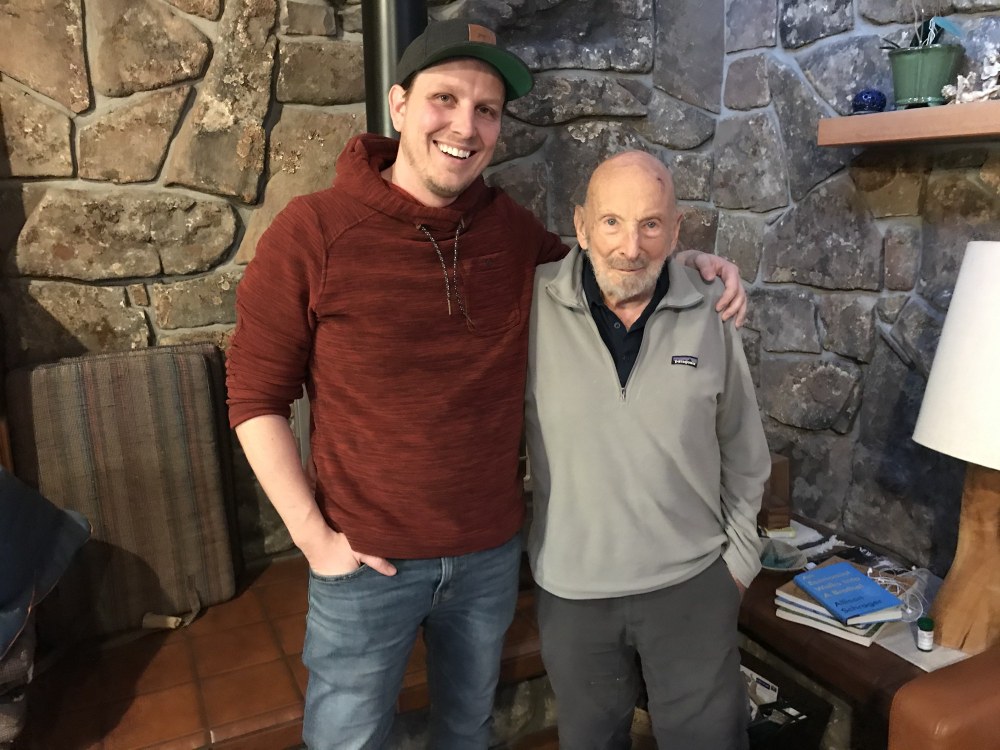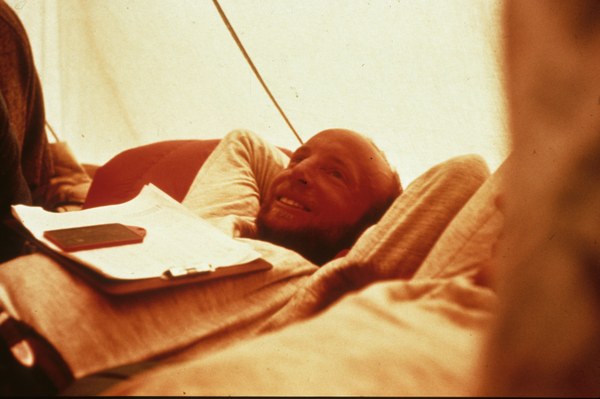
When I asked Tom Hornbein about his relationship with reading over his 89-year lifespan, he didn’t answer, he simply rotated his computer forty-five degrees so I could see the room behind him on our Skype call. What was revealed was an entire wall of books, most of them about outdoor adventures, many of which were Mountaineers Books titles. Buried in his stack is surely his own book, Everest: The West Ridge, which follows his and partner Willie Unsoeld’s groundbreaking 1963 first ascent of Mt. Everest via the treacherous West Ridge. It doesn’t take a bibliophile to recognize that this collection is the mark of fervor; his ice axe long stowed, Hornbein now sits on a mountain of literature.
To many, a book just is a book. Slow entertainment compared to the distractions of today. But for those engulfed in the industry, a book is something much more: an idea that tumbles into years of work and a touch of madness, then agents and editors, publishing houses, acquisition teams, design work, paper stock, font size, margins, printing, distribution, marketing, reviews, interviews, readings, signings, etcetera, etcetera. Then, most importantly, there’s the readers. What this adds up to, hopefully, is the inexplicable magic of a good narrative.
One way to create this magic is with the mission-based model of nonprofit publishing, like we use at Mountaineers Books. This unique model opens the door for philanthropic support, with the incentive of a tax deduction for donors who want to align with our mission, and allows us to focus on our organization’s goals, rather than financial returns for investors. Using donor funds we can amplify influence by establishing platforms that deliver on larger programmatic impacts and giving greater attention and support to our authors. We think of our authors as ambassadors of our efforts, and as inspiration to our readers and the next generation of adventurers.
The process isn’t easy and is often unpredictable, as Hornbein told me himself. He said that writing his book about Everest was harder than actually climbing the mountain. However, it can hold unexpected benefits too. Through working with Mountaineers Books staff on the special edition commemorating the 50th anniversary of his summit, he came to understand the true significance of our publishing impact.
Since our initial partnership on Everest, Hornbein has become an integral figure in our publishing community He sits on our Legends & Lore book advisory council, has introduced us to new writers and narratives, and is a recurring philanthropic donor. Through all this, he has seen firsthand how through charitable donations, we as a nonprofit publisher can invest in stories that connect people to the life-changing world of outdoor adventure.
And that’s precisely why I wanted to ask a few questions about his choice to financially support Mountaineers Books, including donating the royalties from his book.
What importance has Mountaineers Books had in your life?
First of all, I read many of the books. Freedom of the Hills, of course, is a classic, and Dee Molenaar’s book, The Challenge of Rainier, is similar. There’s a lot of history there and the stature of Mountaineers Books stands out amongst all other outdoor publishers because they are such a major force. The history of mountaineering is a precious part of the foundation on which outdoorspeople now dwell and it needs to be preserved. My book is a good example because with its re-publication, Mountaineers Books kept it in print and kept it alive. And that’s what they are doing now with the Legends & Lore series, as well as the other practical publications they put out – they keep books alive. Then of course, there is the Braided River imprint, which I consider the most precious of what Mountaineers Books does because those publications help us to continue having a planet to live on.
Have you seen Mountaineers Books play a critical role in conservation and environmentalism in your time as an outdoorsman?
Absolutely. They’re using storytelling to make a positive change. And that’s where my personal passion is at this stage in my life. We need major publication forces to drive this change. Mountaineers Books does that.
Helen Cherullo (the Publisher at Mountaineers Books) is one of my heroes. We’ve really grown to be very close friends and I have huge admiration for her. Dave Brower, who was the original publisher of my book through Sierra Club Books, is another hero of mine. Dave was really a driving force for environmentalism in publishing and Helen has been the visionary who picked up where he left off with Braided River.
What do you think would be missing from the world if we didn’t have Mountaineers Books?
Well that’s a question! If there was no Mountaineers Books, one could imagine that there would be an educational vacuum. We need these incredible and creative people who are all willing to put themselves out there, into this world, to write, photograph, and video with passion and to capture a message to continue collaborating with Mountaineers Books. I have huge admiration for what they all put themselves through. It’s not risk-free by any means.
 Tom Hornbein calculating the plan for Everest's West Ridge. Photo by Willi Unsoeld.
Tom Hornbein calculating the plan for Everest's West Ridge. Photo by Willi Unsoeld.
Hornbein is right, of course. Publishing is not without risk. But as a nonprofit publisher, we are able to make a difference by choosing stories we believe deserve to be shared. With the support of generous donors like you, we can transport stories from the mountains and into the hands and hearts of thousands of readers everywhere. Today, Mountaineers Books has more than 800 titles in print that empower our outdoor community - locally and around the globe - which include guidebooks, instructional guides, histories, biographies, natural histories, adventure narratives, and conservation titles.
As we enter our 60th anniversary of for Mountaineers Books, we reflect on our journey and look to the future of our organization. We publish to educate, to conserve, to inspire, and to protect. We do so with the hope that this becomes a collaborative effort with our readers and an opportunity for the community to put their collective power toward the preservation and propulsion of important storytelling.
That’s why I donate to Mountaineers Books. That’s why Hornbein donates, too. Because books matter. Protecting our history, culture, and wild places matters. We invite you to do the same – help us ensure that Mountaineers Books is around for another 60 years, shaping lives and bringing stories to life.
Main Image: Author Tyler Dunning with Tom Hornbein in his home in Estes Park, Colorado. Photo courtesy of Tyler Dunning.
Inspired to support Mountaineers Books? You can make a donation online any time or by calling 206-521-6006.
This article originally appeared in our Spring 2020 issue of Mountaineer Magazine. To view the original article in magazine form and read more stories from our publication, visit our magazine archive.
 Tyler Dunning
Tyler Dunning